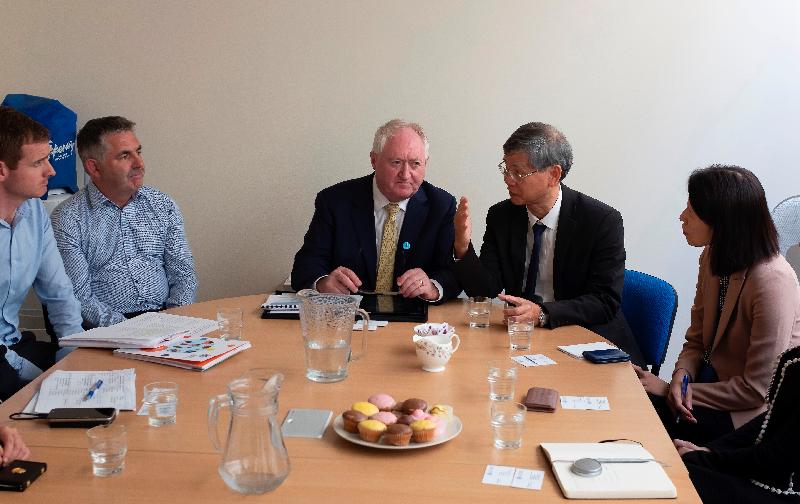LCQ3: Use of site reserved for phase two development of Hong Kong Disneyland
Following is a question by the Hon Andrew Wan and a reply by the Acting Secretary for Commerce and Economic Development, Dr Bernard Chan, in the Legislative Council today (July 4):
Question:
Some members of the public have suggested the development of transitional housing using a 60-hectare site which has been reserved for the second phase development of Hong Kong Disneyland (Phase 2 site), in order to improve the living environment of more than 200 000 residents in sub-divisions of flat units (commonly known as “sub-divided units”). On the other hand, a Hong Kong-based event organiser signed co-operation agreements with a Dutch floriculture expert last month on the development of a flower-themed garden in Hong Kong, and is considering locating the garden at the Phase 2 site. In this connection, will the Government inform this Council:
(1) of the criteria adopted for vetting and approval of applications for short-term tenancies for the Phase 2 site; whether it has received or approved the application concerning the flower-themed garden;
(2) whether the Government conducted, in the past three years, any study on the construction of transitional housing at the Phase 2 site; if so, of the details and the outcome; if not, the reasons for that; and
(3) given that due to the restrictions imposed by the Deed of Restrictive Covenant signed between the Government and the Hongkong International Theme Parks Limited (HKITP), the permitted land uses of the Phase 2 site do not include residential use, whether the Government will discuss with HKITP amending the Deed to the effect that the provision of transitional housing such as modular housing is a permitted land use of the site; if so, of the details and the expected completion time for the discussion; if not, the reasons for that?
Reply:
President,
In 1999, the Government and the Walt Disney Company (TWDC) reached an agreement to develop the Phase 1 of Hong Kong Disneyland Resort (HKDL) at a reclaimed site of about 126 hectares at Penny’s Bay, Lantau Island. Since its opening in September 2005, HKDL has been in operation for nearly 13 years. It is a major component of the tourism infrastructure in Hong Kong and one of the most popular tourist attractions for both local and non-local visitors. It also helps consolidate our position as an international premier tourist destination.
In its first 12 years of operation, HKDL received over 70 million guests. Their additional spending in Hong Kong was around $166.2 billion, which generated total value-added of $90.9 billion for Hong Kong’s economy, equivalent to 0.35 per cent of Hong Kong’s gross domestic product. HKDL also created a total of 232 500 jobs for Hong Kong’s economy over the same period, providing considerable job opportunities for frontline workers and the Hong Kong’s tourism industry.
Over the years, HKDL has been strengthening its appeal to visitors through sustained efforts to enrich its attractions and entertainment offerings. Apart from the new ride Iron Man Experience and the new hotel Disney Explorers Lodge launched last year, HKDL has been actively taking forward its expansion and development plan since the second half of last year and various newly built attractions are being launched progressively from this year to 2023.
When the development of HKDL was finalised in 1999, the Government, considering HKDL’s further expansion and development in future, agreed to reserve a reclaimed site of around 60 hectares to the east of HKDL for its possible Phase 2 development (the Phase 2 site). The Government understands the concerns of this Council and the general public about better utilisation of land, and thus considers from time to time whether the Phase 2 site can be put to compatible use(s). In fact, the Phase 2 site was used for hosting some short-term activities in the past, such as sports activities and group events.
Last month, there was an announcement in the Netherlands about the plan to develop an European design flower-themed garden in Hong Kong, and that the organisers concerned are considering locating the garden at the Phase 2 site. The Government welcomes this proposal which, if materialised, would not only bring a new attraction for enjoyment by our local community, but would also enrich our tourism offerings, and thereby further enhancing Hong Kong’s position as an international premier tourist destination.
My reply to the three parts of the question is as follows:
(1) According to the Option Deed signed in 2000 between the Government and the Hongkong International Theme Parks Limited (i.e. the joint venture with the Government and TWDC as shareholders, “the joint venture”), the joint venture has an Option to purchase the Phase 2 site for taking forward HKDL’s further development.
Before the joint venture exercises the Option for the Phase 2 site, the site can be put to short-term uses that comply with the permitted uses as listed in the Deed of Restrictive Covenant (DRC), including recreational, sports and cultural facilities, etc. When considering these short-term uses, we also need to take into account whether such uses are compatible with the use and atmosphere of HKDL.
As at end-June this year, the Government has not yet received any short-term tenancy application from the organisers of the flower-themed garden for developing the garden at the Phase 2 site.
(2) & (3) As mentioned in my reply to part (1) above, before the joint venture exercises the Option for the Phase 2 site, the short-term uses of the site have to comply with various permitted uses as listed in the DRC, including recreational, sports and cultural facilities, etc, but not residential use (e.g. development of transitional housing). Considering the Option Deed signed in 2000, the Government agrees to reserve the Phase 2 site for HKDL’s possible Phase 2 development. We have no intention to change the existing land use arrangements.
In the light of the proposed short-term uses of the Phase 2 site recently received, we will continue to follow up with the relevant parties and make announcement at an appropriate juncture, with a view to further exploiting the recreation, tourism and entertainment positioning in the vicinity of HKDL. This would be conducive to HKDL’s on-going development, the Hong Kong’s tourism industry as well as the overall economy.
Thank you, President. read more




